A History of the County of Berkshire: Volume 4. Originally published by Victoria County History, London, 1924.
This free content was digitised by double rekeying. All rights reserved.
'Parishes: Little Wittenham', in A History of the County of Berkshire: Volume 4, ed. William Page, P H Ditchfield (London, 1924), British History Online https://prod.british-history.ac.uk/vch/berks/vol4/pp380-384 [accessed 19 April 2025].
'Parishes: Little Wittenham', in A History of the County of Berkshire: Volume 4. Edited by William Page, P H Ditchfield (London, 1924), British History Online, accessed April 19, 2025, https://prod.british-history.ac.uk/vch/berks/vol4/pp380-384.
"Parishes: Little Wittenham". A History of the County of Berkshire: Volume 4. Ed. William Page, P H Ditchfield (London, 1924), British History Online. Web. 19 April 2025. https://prod.british-history.ac.uk/vch/berks/vol4/pp380-384.
In this section
LITTLE WITTENHAM
Witeham, Witteham (xi–xiii cent.); Wittenham (xiii cent.); Wyttenham (xiv cent.); Whytenam (xv cent.); Wittingham, Abbatts Witnam, Witnam, Lytell Wytnam (xvi cent.); Little Wittenham, East Wittenham (xvii cent.).
The ecclesiastical parish, conterminous with the civil parish of Little Wittenham, 888 acres in extent, lies on the right bank of the Thames. The early boundaries (falsely ascribed to 862) included the northeast portion of the present Long Wittenham. (fn. 1) They started at Gateclife (fn. 2) (? on the Thames), went up by Scillinges Brook, eastward to Caberes Back (or ridge); thence westward to the 'headdan treowe', to the new trench (furh); along the trench, over Crowan Brook, to the new trench, so to the highway, and along this north-west to the Thames. (fn. 3) The present road lead ing north from the west side of the village stops where it meets the road going westward to Long Wittenham, but is continued by a field track which is the parish boundary as far as the site of Little Town, a row of cottages removed in the early 19th century. (fn. 4)
The subsoil is Gault, Upper Greensand, Gravel and Alluvium, the soil clay and chalk; in the hills clay and sand rest on traces of the lower chalk. About five-eighths of the present parish is arable land, twoeighths permanent grass, and one-eighth woods and plantations. (fn. 5) The chief crops are wheat, barley, oats and beans; the woods contain flora and fauna of exceptional interest. (fn. 6)
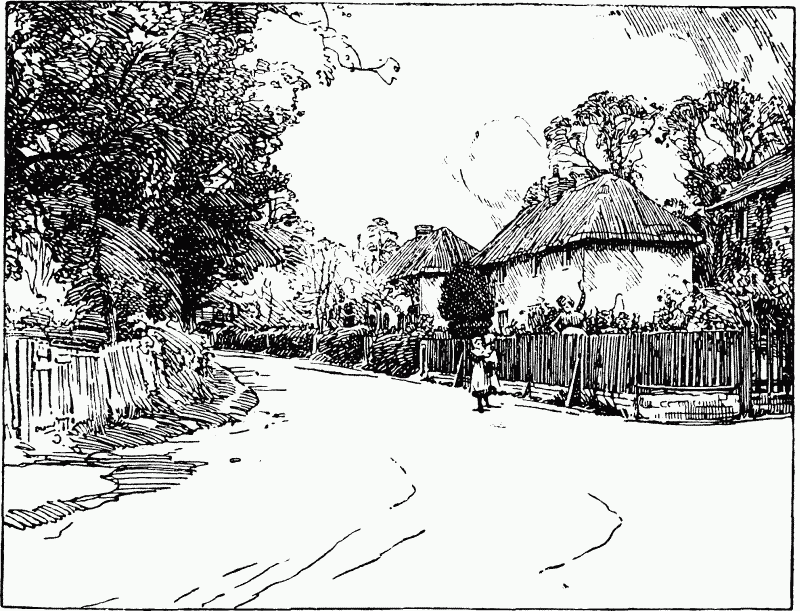
Little Wittenham: A View in The Village
The village, on high ground on the south bank of the Thames, is quite small, with a few thatched cottages. The church stands close to the Thames, about half a mile from Day's Lock, near which is an iron bridge connecting the village with Dorchester (Oxon.). To the south-west of the church is a substantial early 18th-century farm-house of red brick. The village street runs south-west from the church, close to which still remain the terraces and yew tree walk of the old manor-house, 'in great decay' in 1784, (fn. 7) and pulled down shortly afterwards. An old half-timbered barn belonging to this house has been turned into stables (fn. 8); the park is now pasture. (fn. 9) A shooting-box known as the Round House in a meadow south of the church, was destroyed about 1838, when weapons and a leaden chest were found under the floor. (fn. 10)
Christmas mummers continued to act until 1862, (fn. 11) and Shrove Tuesday and May Day celebrations are still kept up.
Matthew Prior is said to have written his poem 'Henry and Emma,' descriptive of this place, under an oak tree here, (fn. 12) and Thomas Ravis, who was Bishop of London in 1607, was incumbent here in 1598. (fn. 13)
The Wittenham or Dorchester Clumps south of the village are two bold chalk hills capped by beech trees. The higher is known from its shape as the Harp, or Round Hill, and in 1716 as the Welsh Harp. It was then stated that human bones had been found there. (fn. 14) The other, Sinodun, (fn. 15) has a hill fort. (fn. 16) There is a local tradition of a battle on Castle Hill, and a fosse, known as the Money Pit, on its eastern side, is supposed to contain buried treasure guarded by a phantom raven. (fn. 17) On a beech tree at this end of the hill twenty lines of verse, now illegible, were inscribed by Joseph Tubb of Warborough Green in praise of the surrounding landscape. (fn. 18)
A stone-paved way, supposed to be Roman, has been traced from the backwater near the bridge to the road opposite the south-east angle of the church yard, and, following this road, past the farm-house on the west side of the churchyard, Bronze Age and Roman objects have been found. (fn. 19) The nuns of Helenstow in Abingdon are said to have removed at the end of the 7th century to Witeham (Wittheham), probably Little Wittenham. (fn. 20)
A present name of interest is Trottamere, the landing-place on the river bank in the wood; it is corrupted into Trotman's, or Devil's, Stairs. The east, south, south-west and north-west slopes of Sinodun are known respectively as Buttings Furlong, Pecks Furlong, Port or Putt Furlong, and Warren Pecks. Other names are Upper and Under Shinnel (where Little Town stood), Old Oxford, Town Furlong, Hop Garden, Hardwells Furlong, Wollens Field, Raw Meadow and Mare Furlong.
Manors
Siward, Bishop of Upsala and coMANORS adjutor-Archbishop of Canterbury, who succeeded Æthelwine as Abbot of Abingdon in or about 1030 and died in 1048, (fn. 21) gave LITTLE WITTENHAM to Abingdon Abbey. (fn. 22) The abbey continued in possession until the dissolution of the monasteries. (fn. 23)
The fishery was appropriated to the kitchener at the abbey, whither a definite quantity of wood, fowls, eggs and lentils was sent from this manor. (fn. 24) Among the issues of the manor in the 14th century were payments for pannage, 'tolcestre,' 'faldgabul,' and wood silver. (fn. 25)
The abbot surrendered the manor with the advowson of the church in the spring of 1538, (fn. 26) and in 1546 Henry VIII granted it to Lord Wriothesley in fee. (fn. 27) In the same year he alienated it to Sir Edmund Peckham, (fn. 28) kt., treasurer and master of the Mint, (fn. 29) who sold it in 1552 to William Dunch of London, (fn. 30) to whom the reserved rent was released and the manor confirmed by Edward VI. (fn. 31)
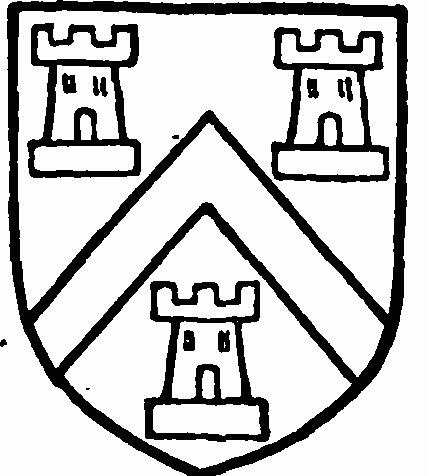
Dunch. Azure a cheveron between three castles or.
William Dunch, auditor of the Mint to Henry VIII and Edward VI, esquire extraordinary of the body to Queen Elizabeth and Sheriff of Berkshire in 1570, (fn. 32) died at Little Wittenham in 1597, leaving a son and their Edmund, (fn. 33) Sheriff of Berkshire in 1587. (fn. 34) Edmund's eldest son, William, knighted in 1603, married Mary daughter of Sir Henry Cromwell and aunt of the Protector, (fn. 35) and died in January 1610–11; his son Edmund, born in February 1602–3, (fn. 36) was heir of his paternal grandfather on his death in 1623. (fn. 37) Edmund was Sheriff of Berkshire in 1633, (fn. 38) and in 1658 was summoned to Cromwell's House of Lords as Lord Burnell of East Wittenham, he having married the co-heir to the Burnell barony. (fn. 39) The title, however, was not confirmed at the Restoration, although he had joined the Committee of Safety in 1659. His son Hungerford succeeded in 1678 and died two years later. (fn. 40) His son and heir Edmund staked and lost this manor to James II, but received it again on condition that the abandoned cards. (fn. 41) He was successively master of the household to Queen Anne and George I, and married a niece of the Duke of Marlborough. At his death, in 1719, he left three daughters and co-heirs, Elizabeth wife of Sir George Oxenden, bart., of Dean in Wingham, Kent; Harriet, who married Robert Montagu, who succeeded as Duke of Manchester in 1739; and Arabella, who married Edward Thompson of Marsden, Yorkshire, died in 1734, and left an only daughter, who died a few months later. (fn. 42) By conveyances of 1765 and 1766 Lord Charles Greville Montagu, second son of Robert and Harriet, conveyed a moiety of the manor to Sir George Oxenden, who thus became possessed of the whole. (fn. 43) Sir George died in 1775, Elizabeth in 1779, leaving a son and heir, Sir Henry, who lived at Little Wittenham and acquired the whole of the estate. (fn. 44) He sold the manor in 1788 to William Hallet (who pulled down the old manor house of the Dunches and built a shooting box), (fn. 45) of whom it was purchased by Nathaniel Dance (fn. 46); he, by royal licence, took the name of Holland in 1800, 'out of his great respect to Charlotte Holland, of Wigmore Street, Cavendish Square, spinster.' In the same year he was created a baronet, but died childless in 1811. (fn. 47) In 1813 the manor was acquired by Robert Earl of Cardigan, (fn. 48) after whose death, in 1837, (fn. 49) it was purchased by George Henry Cherry of Denford in Kintbury. (fn. 50) It has since descended with Denford (q.v.), and now belongs to Mr. Apsley George Benet Cherry-Garrard. (fn. 51)
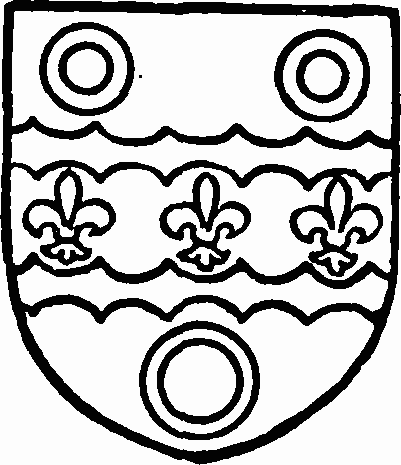
Cherry. Argent three fleurs de lis fesseways within two bars engrailed all between three rings gules.
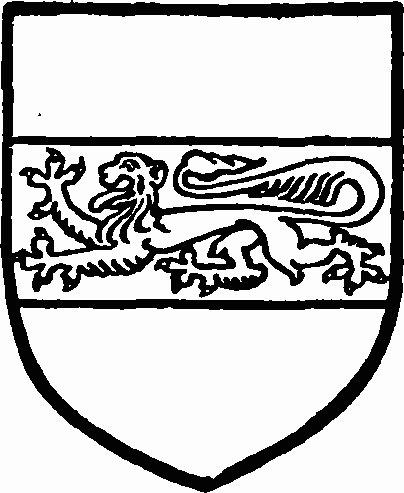
Garrard. Argent a fesse sable with a lion passant argent thereon.
The reputed manor of BRYLLES seems to have been in the possession of the family of Bryll in the 16th century. Alice daughter of William and Margery Bryll married William Yonge, who died seised of the manor in 1531 (fn. 52); no further mention of it has been found.
For the property of Nutley Abbey see Long Wittenham.
Church
The church of ST. PETER (fn. 53) consists of a chancel with north vestry and organ chamber, nave, west tower and south porch.
With the exception of the 14th-century west tower the church was entirely rebuilt in 1863, but preserved in the vestry are two water-colours of the old church. They show a pointed chancel arch dying on to the responds, a three-light east window and a four-centred plastered chancel roof. There was an Elizabethan south chapel opening into the chancel by a wooden arcade, and containing the monuments of the Dunch family. The nave had a flat plaster ceiling. The modern work of the nave and chancel is Gothic of late 13th-century type with a three-light east window and a pointed chancel arch. A vestry and organ chamber were added on the north side in 1902.
The west tower is four stages high with diagonal western buttresses and embattled parapet; at the south-east angle is a projecting turret finished with an embattled parapet and an octagonal pyramidal stone roof. The tower arch is two-centred and of two chamfered orders dying into the side walls. The 14th-century west window is of two lights and the second stage has cruciform loops. The third stage is lighted by pointed single-light windows and the bell-chamber by two-light windows of early 15thcentury date. The 15th century font is octagonal, with a moulded base.
The church contains numerous brasses and monuments. In the chancel is an altar tomb with a Purbeck marble slab and brass to Geoffrey Kidwelly (d. 1483) with a well-executed figure in civilian costume and two shields, party palewise a leaping wolf. On the front of the tomb are four panels with as many stone shields with the same arms, the wolves being placed 'regardant' in pairs. Above the tomb is a low depressed and cusped canopy flanked by embattled pinnacles with iron prickets at the top; the soffit has a sloping vault and the back of the tomb has quatrefoil panels with blank shields. On the chancel floor is a brass to John Churmound, rector (d. 1433), with a small figure in mass vestments and indents of two shields. Near it is another to David Kidwelly (d. 1454), 'hostiarius aule regis Henrici VI,' with a small figure in civilian dress, with an obliterated quarterly coat of arms. A fairsized figure of a lady commemorates Cecily wife of Geoffrey Kidwelly (d. 1472), and a rudely engraved figure on a plate is to Anne daughter of Henry Dunch and Anne his wife (d. 1683). On the west wall of the nave is a brass commemorating Anne wife of Edmund Dunch (d. 1627).
Under the tower is another brass inscription to William Winchcombe (d. 1614), with his arms, a cheveron engrailed with three cinquefoils thereon between three lapwings and a chief charged with a fleur de lis between two spear-heads, all impaling Norreys. Against the north wall, in a Jacobean stone frame, is a brass plate with kneeling figures of William Dunch and his wife Mary (Barnes); the date is blank, and there are two enamelled shields of Dunch and Dunch impaling Barnes, two bars between six voided lozenges. Above are two Jacobean stone arches, the first inclosing a long epitaph to Mary Barnes, and the second with a kneeling figure, in armour, of John Barnes, with his arms above. Against the west wall is placed a handsome alabaster monument to Sir William Dunch (d. 1611), Mary his wife, and William his son (d. 1594). The male effigy reclines on one elbow Purbeck marble slab and brass to Geoffrey Kidwelly and is dressed in rich armour, the female figure below it is recumbent with a ruff and stomacher; both have been coloured and gilt. On the front of the altar tomb are figures of four sons, three daughters and two chrisom children. On the wall at the back are two shields, both bearing Dunch quartering Barnes, Fettiplace and Kenwarde, all impaling the arms of Cromwell, with six quarterings. The broken remains of the canopy of this monument are stored in the vicarage barn. On the tower floor is a slab to Mary (Dunch) wife of William Winchcombe and Sir Edward Clarke (d. 1646), with a shield of Clarke, a fesse with three roundels thereon between three crosses paty, impaling Dunch.
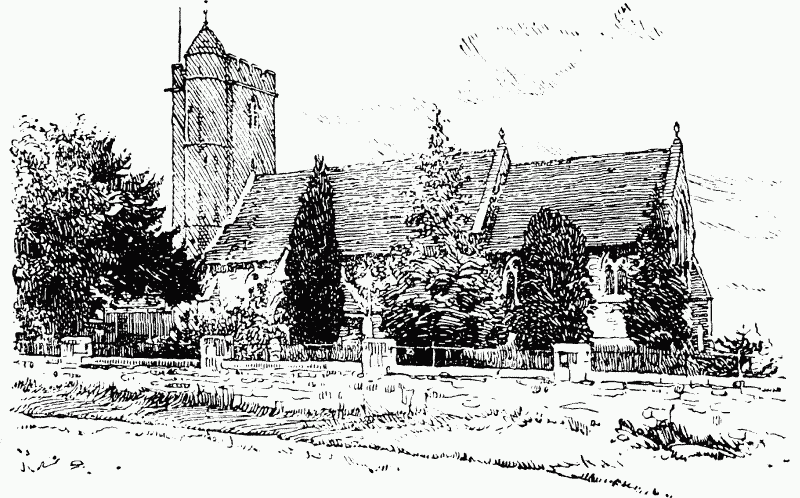
Little Wittenham Church From The South
There is a ring of five bells.
The plate consists of a silver flagon (c. 1640) inscribed 'the gift of Lady Mary Clarke widow'; a silver gilt chalice with three rubies (c. 1696–7) and a silver gilt cover paten inscribed 'R.C. 1714' (Robert Cooke, rector).
The registers begin in 1538.
Advowson
There was a church in the manor in 1086, (fn. 54) and the advowson descended with the manor until the sale of the latter to William Hallet in 1788. (fn. 55) It was sold by William Hallet to Edward Hilliard. (fn. 56) Litigation followed, and the matter was not settled in 1802, (fn. 57) but finally the advowson was retained by the Hilliards; Edward gave it to his son the Rev. John, who bequeathed it to his son William. William sold it in 1884. (fn. 58) It was held in 1885 by Frederick Bodenham, from 1886 to 1895 by trustees, and from 1896 to 1900 by the Rev. S. C. Hayward. In 1900 it was purchased by Mrs. M. F. Howland of Doddington Vicarage, Northumberland, the present patron. (fn. 59)
Charity
In 1640 Lady Mary Clarke, by her will, left £10 to be lent to two poor inhabitants, and the interest paid to the poor, to which £7 was subsequently added by 'the butler and the brewer.' The principal sum, with accumulations, is now represented by £34 3s. 7d. consols with the official trustees. The annual dividends, amounting to 17s., are accumulated until they amount to about £5, which is distributed in coals and other articles in kind.